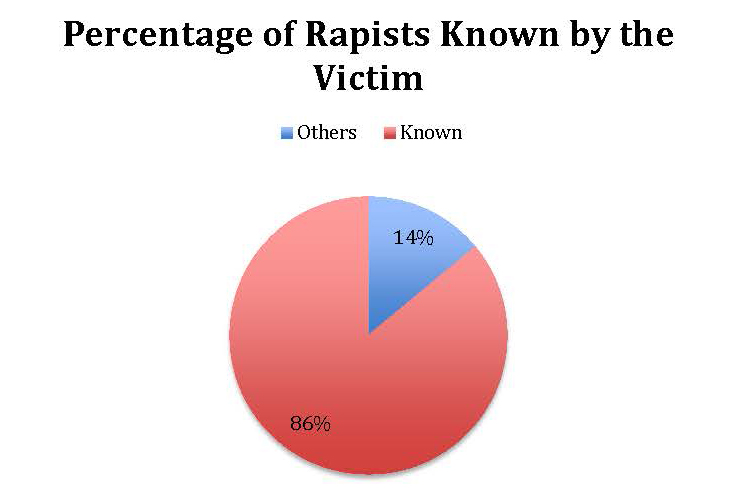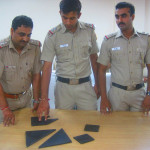Sexual violence has been a hot topic in Delhi for a few years now, and it doesn’t look like that will change anytime soon, especially since the rape of the 4 year old girl over the weekend. Since the Nirbhaya case, new pledges for safer cities and protocols, trainings, awareness are made every day. Despite the global attention, the outcry and the pledges women in Delhi don’t feel safer and rape doesn’t seem to be going down. A new report from the Delhi Police by commissioner BS Bassi has come out on rape, let’s look at those findings and deconstruct them a bit.


The data shows that out of 1,656 of total reported rapes, 105 accused were aged up to 18 years, while 487 were between 25 and 35. It also found that 647 accused had studied up to Class X, 318 were Class XII passouts and 39 graduates. There were 423 illiterates or school dropouts. It was also found that 60.83% cases were reported from the poorer strata of the society.
Now, this begs the question are those from lower economic status more likely to rape? Or are victims more comfortable and feel more confident going to accuse less educated and poorer men (or women), than those in the higher strata? Especially since they hold more power and it is widely thought that poor strangers are more likely to rape? Time and time again studies have shown that rape isn’t correlated with education and income, yet reported rapes may tell us a another side of the story.


So is it fear of retaliation? Do rapists from higher social strata and higher income have better methods of defense and more elaborate strategies to ensure victims keep their mouth shut? I’d be of the opinion that it’s easier to accuse someone who is equal and/or inferior to you in terms of social strata, than a doctor who is well respected, a politician, your boss etc.
The Police Report has done a great job at showing the true face of rape: familiarity. Among those arrested, 38.89% were friends of the survivor out of which 25.31% were live-in-relationships in which the accused had refused to marry the woman. The study also shows 16.69% of the accused were neighbors and 14.07 % family members.
Therefore, the vast majority of assailants are people that victims know, trust, and interact with. It is thus not surprising that women don’t feel safer in Delhi, and rape is still rampant. It becomes a vicious cycle when the only stories highlighted in the media are those of strangers, in the streets, and hearing “Delhi Capital of Rape”, without deconstructing the meaning or numbers. This leads to skewed perspectives, inappropriate solutions and heightened cycles of fear. Therefore, the discourse on safer cities, although extremely important for women in Delhi, is missing the point and hiding the true face of rapists.
Currently, the report says that there are 859 patrol vans to assist women travelling late or who are stranded. Police have also deployed motorcycle patrols, emergency response vehicles for women’s security. Cops are also posted outside girls’ schools and colleges.
Delhi Police has proposed compulsory self-defense training in schools for girls. For safety of women using public transport, police has introduced Special Squad for Women’s Protection. This squad travels in civvies to ensure no girl is being harassed in buses. A drive was also launched to catch youths passing lewd remarks and misbehaving with women in buses and public places under operation Shishtachar.
This is an amazing response and one that must be applauded. Indeed the police is taking the issues seriously, and tackling it head on in its domain- the public sphere. Plus, we must not forget, rape is not the only thing women fear in the streets, thus more police awareness can only lead to a safer city. However, as the report highlights the majority of rapes (85.02%) happens in houses, so behind closed doors.
It’s time to push for a better understanding of rape- again- rape so often shows a familiar face, and we know this, so why aren’t we making a bigger effort at teaching and educating men to respect women’s boundaries, on consent, pushing harsher punishment? We should be teaching to those welcoming victims that it’s harder to be strong and not afraid when someone you know is manipulating you, hurting and being violent with you. Self defense when it’s your best friend or uncle is less effective. Not to mention that methods of defense tend to not be effective when you’re young, petrified with fear, confused as to why someone you trust, and is supposed to be protective, is hurting you. It must be highlighted that the 2014 National Crime Records Bureau (NCRB) data shows that 71 victims were below the age of six, and 806 were between 18 and 30. We must not forget children comprise a significant number of victims, and that means different responses and a change in attitudes.
However, these numbers also mean that there is more reporting from younger women who feel more empowered to speak out. This may mean that they have more and better resources to defend themselves, and are more aware of their rights. This is the generation of the Delhi rapes and they’re breaking the silence.
This tendency seems to be strengthening as “In 2015, 9,223 women approached the police control room, 39,502 called the helpline and 25,549 survivors went to the 24X7 police station,” said Delhi Police spokesperson, Rajan Bhagat.
Women are accessing help and resources. Change is happening, now they need follow up. Reporting is a first step, police accepting those complaints is another, and convictions are the next. Working to follow up on the reporting, and punishing criminals, is a necessary part of justice to support victims if we want to make Delhi a truly safer city for everyone, and an intolerable place for all rapists.
Donation for Centre for Social Research to Join our effort in rehabilitating Domestic Violence
Discuss this article on Facebook




